调查问卷的设计与开发
【精品】通用在线问卷调查系统的设计与实现_毕业论文设计

计算机系本科毕业(设计)论文课题名称通用在线问卷调查系统的设计与实现专业计算机科学与技术姓名学号指导教师二零一零年六月目录1 引言 (2)1.1开发背景及研究意义 (2)1.2系统简介 (2)1.3系统开发环境 (2)2 需求分析 (4)2.1用户需求描述 (4)2.2技术可行性分析 (4)2.3系统功能需求分析 (5)3 系统设计 (7)3.1系统功能设计 (7)3.2数据库设计 (7)4 系统实现 (12)4.1注册登录模块的实现 (12)4.2问卷调查模块的实现 (13)4.3用户管理模块的实现 (14)4.4问卷管理模块的实现 (15)4.5问卷结果分析模块的实现 (16)5 系统测试与维护 (18)5.1系统测试 (18)5.2系统维护 (19)6 结束语 (20)致谢 (21)参考文献 (22)通用在线问卷调查系统的设计与实现摘要:随着社会和网络技术的发展,很多行业需要掌握大量的信息来了解特定的用户需求,但传统的纸制问卷调查具有片面性和局限性,而国内外较为流行的统计软件如SPSS,SAS 等,虽然具有较强的统计输出功能,但需要大量的人工操作,同时需要较深的软件相关知识,不能满足调查者需要。
为了改变这一现象,本人主要运用软件工程的指导方法,选用B/S(Broswer/Server)模式设计的方案,采用Access 2003作为数据库,使用ASP技术在Dreamwaver软件上开发出了通用在线问卷调查系统,使用该系统用户可以进行问卷浏览、问卷做答并提交等操作,管理员则可以根据调研人员的需求添加问卷,管理问卷,查看问卷统计结果,同时可以对用户进行管理,并通过设置登录控制权限以确保答卷信息的真实性和可信度 ,进而获得有参考价值的统计信息。
在线调查的通用性、开放性、方便性和灵活性,使调研人员可以足不出户就能进行相关领域的问卷调查,且不受调查地点的限制,同时也减轻被访者的答题负担,使数据的回收更及时,进而有效降低调研方面的成本和人力投入。
问卷调查的设计和实施步骤

问卷调查的设计和实施步骤1. 引言问卷调查是社会科学研究中常用的数据收集方法之一。
通过收集受访者的观点、态度和行为,揭示出一定的信息,为研究提供可靠的数据支持。
设计和实施问卷调查需要遵循一系列步骤,以确保数据的准确性和可靠性。
本文将介绍问卷调查的设计和实施步骤。
2. 步骤概述问卷调查的设计和实施主要包括以下几个步骤:1.确定调查目标和研究问题2.选择调查方法和问卷类型3.设计问卷内容和结构4.进行问卷预测试5.选取调查样本和受访者6.实施问卷调查7.数据收集和整理8.数据分析和结果呈现接下来将详细介绍每个步骤的具体内容。
3. 步骤详解3.1 确定调查目标和研究问题在进行问卷调查之前,需要明确调查的目标和研究问题。
通过明确调查目标和研究问题,可以指导后续步骤的进行,并确保问卷的设计和实施与研究目标一致。
3.2 选择调查方法和问卷类型根据调查目标和研究问题,选择适合的调查方法和问卷类型。
常见的调查方法包括面对面访谈调查、电话调查、网络调查等。
而问卷类型可以分为开放性问题、封闭性问题、多项选择问题等多种形式。
3.3 设计问卷内容和结构根据调查目标和研究问题,设计问卷的内容和结构。
问卷应该包括相关的问题和选项,并合理安排问题的顺序。
在设计过程中,需要确保问题清晰明确、不含歧义,并避免引导性的问题。
3.4 进行问卷预测试在正式实施问卷调查之前,进行问卷的预测试。
预测试可以帮助发现问卷中存在的问题,比如问题难度、选项满意度等。
通过预测试,可以及时调整问卷的内容和结构,提高问卷的质量。
3.5 选取调查样本和受访者在实施问卷调查之前,需要确定调查样本和受访者。
调查样本应该具有代表性,能够真实反映研究问题的特征。
选择合适的调查样本和受访者有助于提高调查的可信度和效度。
3.6 实施问卷调查根据确定的调查样本和受访者,开始实施问卷调查。
根据选择的调查方法,可以选择面对面访谈、电话调查或者在线调查等方式进行问卷的发放和回收。
调查问卷的设计与制作

第六章研究性学习中的信息技术系列教学设计主题:利用Word制作调查问卷的一般方法教前语:问卷调查是我们开展研究性学习的过程中,获取第一手资料的重要途径。
从技术角度来讲,高中阶段我们设计调查问卷的方式为利用Word编辑加工并打印的纸质问卷和以网页为依托的网络调查问卷。
在文本信息加工这一章节,我们介绍的主题是:如何利用Word制作一份形式美观、内容充实的调查问卷。
教学资料说明:本节课,我们提供给学生的资源如下:如何设计调查问卷l 如何设计调查问卷理论篇上.docl 如何设计调查问卷理论篇下.docl 练习实例:中学生上网情况的调查问卷.doc其他调查问卷设计范例l 90后中学生偶像问题调查问卷.docl 中学生的消费与消费观问卷调查.docl 中学生课余生活调查问卷.docl 中学生学习生活调查问卷.docl 中学生心理健康量表.doc教学设计思路:课题引入:花5分钟时间介绍教学资源包有关说明,布置本节课学习任务一、阅读理解:了解调查问卷的一般理论知识;花10分钟时间让学生仔细阅读资源库中“如何设计调查问卷”中的“如何设计调查问卷理论篇上.doc”和“如何设计调查问卷理论篇下.doc”;二、实践操作:以“中学生上网情况的调查问卷.doc”为设计原型,进行修饰完善、美化加工,以期从内容和形式上“吸引别人的眼球”;三、分享交流:浏览分析同伴作品,回答下列问题:1、我认为我的作品中最大的优点为2、最吸引我的调查问卷作品是四、学以致用:浏览其他调查问卷设计范例,思考自己的研究性学习课题中是否需要进行相关调查问卷的设计。
教后记:充分相信学生的实力本节课作为前面利用Word进行文献综述报告的撰写的后续课,学生对于利用Word如何编辑加工文本已经有了一定的基础,而且对于一份调查问卷的设计,除了内容要求外,格式上我希望学生们能使出自己十八般武艺精心打造一份精美的“调查问卷”,鉴于此,我不打算将自己的设计模式强加给学生,而是让学生利用所学知识自由发挥,目标只有一个:让自己的问卷“吸引住别人的眼球”。
问卷调查的设计与实施

实施问卷调查的路径
• 邮寄调查 • 互联网调查 • 电话调查 • 群体调查 • 面对面访谈调查(将非结构性访谈与结
构性访谈结合起来更有效)
问卷调查的信度和效度
• 信度:增加问题项/标准化实施
• 效度: 内容效度 构想效度 效标关联效度
为被调查者保密
• 调查的伦理学视角: 是否需要保护被调查者的匿名性? 是否需要对被调查者的反应保密?
• 行为:(是否需要保密,涉及隐私?)
定义你的研究主题
• 准确表达你的研究主题 • 限量:不要指望“一句话问完天下事”
编制问卷项目1:选择项目类型
• 开放型问题: • 封闭型问题 • 部分开放型问题: • 评定量表型问题:
开放型问题
• 完全不限制回答方向和内容的问题。 • 如问卷合成的目的是使问卷看起来流畅、 舒服、条理分明。
• 人口统计学问题不必放在开头。 • 问卷条理性;关联问题放在一起。(必
要的“航标”) • 问题的顺序:考虑低受教育者的影响 • 敏感问题放在中间位置
三、问卷调查的实施
• 选择问卷调查的路径 • 邀约 • 发放 • 提醒 • 回收 • 感谢与结束
小礼品、感谢信、反馈路径等
要改进的问题有哪些?
封闭型问题
• 把所有可能的回答方式均列举出来供被调 查者选择的问题。
• 如:你认为在心理学的班级的男生和女生 的数量最好是 A 男生多 B 女生多 C 平均招生男女生 D 无所谓
部分开放式问题
• 提供部分答案选项,同时邀请被调查者 根据自己的情况补充其他可能的答案的 问题。
• 如:你觉得哪些职业的社会地位高? A 公务员 B 教师 C 医生 D 其他_______________
评定量表式问题
在线问卷调查系统的设计与实现

一、概述随着互联网的普及和发展,问卷调查作为一种常见的数据收集工具,已经逐渐由传统的纸质问卷转变为上线问卷调查。
上线问卷调查系统的设计与实现,对于提高数据收集效率、降低调查成本、保障数据安全都具有重要意义。
本文将就上线问卷调查系统的设计与实现进行探讨,从系统需求分析、架构设计、技术实现等方面展开讨论,旨在为相关领域的研究和实践提供参考。
二、系统需求分析1. 用户需求分析上线问卷调查系统的用户包括问卷设计者和参与者两个角色。
问卷设计者需要拥有创建、编辑、发布问卷的权限,参与者则需要能够方便快捷地参与调查并提交答卷。
系统需要满足用户的操作便捷性、界面友好度、数据安全性等方面的需求。
2. 功能需求分析在功能需求方面,系统需要具备问卷设计、问卷发布、数据收集与分析等功能。
问卷设计包括题目编辑、选项设置、逻辑跳转等功能;问卷发布包括生成调查信息、选择调查对象等功能;数据收集与分析包括答卷收集、数据统计、报告生成等功能。
三、系统架构设计1. 前端架构设计前端是用户与系统交互的界面,需要具备良好的交互体验和界面设计。
在前端架构设计中,可以采用Vue.js、React等流行的前端框架,结合HTML、CSS、JavaScript等前端技术,实现问卷设计、发布和参与等功能。
2. 后端架构设计后端是系统的核心部分,需要处理用户的请求、数据存储与处理等功能。
在后端架构设计中,可以采用Spring、Django、Express等后端框架,结合MySQL、MongoDB等数据库技术,实现用户管理、问卷管理、数据统计等功能。
3. 网络架构设计网络架构设计是系统部署和运行的基础,需要考虑系统的性能、稳定性和扩展性。
可以采用分布式部署、负载均衡、缓存技术等手段,保障系统的高性能运行。
四、技术实现1. 问卷设计与发布在问卷设计与发布方面,可以借助jQuery、Bootstrap等前端技术,实现题目编辑、选项设置、逻辑跳转等功能;借助Node.js、Django 等后端技术,实现问卷创建、生成调查信息、选择调查对象等功能。
如何进行有效的问卷设计与调研实施

如何进行有效的问卷设计与调研实施问卷调查是一种常用的数据收集方法,可以帮助研究者了解受访者的观点、态度和行为等信息。
然而,要设计和实施一次有效的问卷调查并非易事,需要考虑到诸多因素。
本文将从问卷设计的准备工作、问题设计、样本选择和实施等方面探讨如何进行有效的问卷设计与调研实施。
一、准备工作在进行问卷设计之前,需要做一定的准备工作。
首先,明确研究目的和调研的背景,确定所要调查的问题和目标。
其次,确定问卷调查的样本大小和结构,以及调查的时间和地点等。
最后,明确问卷设计的步骤和时间计划,确保问卷调查的顺利进行。
二、问题设计问卷的问题设计是问卷调查中最为关键的环节之一。
问题设计要求问题清晰明确,能够准确捕捉被调查者的信息,并且不引导回答者的回答。
以下是一些问题设计的原则和技巧:1.选择合适的问题类型:问题类型主要包括开放性问题和封闭性问题。
封闭性问题通常有单选、多选和量表等形式,可以方便统计和分析。
而开放性问题可以让受访者自由发表意见,但处理和分析困难。
2.避免双重否定和模棱两可的问题:问题应该避免使用双重否定的表达方式,以免造成回答者的困惑。
同时,问题也应该避免使用模棱两可的语言,要确保问题的意图明确。
3.注意问题顺序和逻辑关系:问题的顺序应该合乎逻辑,从整体到细节,从简单到复杂。
同时,问题之间的关系也要注意,避免提问的冗余和重复。
4.充分考虑控制变量:在设计问题时,需要考虑到潜在的控制变量,尽量确保问题能够独立地衡量所需要的信息。
三、样本选择样本选择是问卷调查中的另一个重要环节。
样本选择要求得到的样本具有代表性,并且能够反映整个受调查人群的特征。
以下是一些样本选择的原则和技巧:1.随机抽样:随机抽样是确保样本具有代表性的重要手段,可以通过随机数表、随机数发生器等方法进行抽样。
2.样本大小的确定:样本大小要根据研究目的、调查的时间和资源等因素综合考虑。
一般来说,样本大小越大,调查结果的可靠性和代表性就越高。
问卷设计法
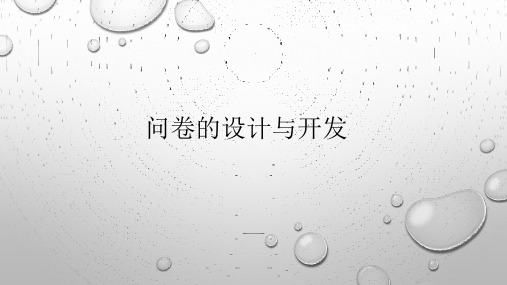
• 在 总体布局上要注意层次分明,一个主题与另一个主题之间要有所区分,尽可能将相同主题的题目放在一 起。在进入一个话题,或从一个话题转入另一个话题时,最好有一个简短的陈述说明。 • (3)主题之间的衔接 • 可以按一定的逻辑顺序来组织不同 主题的题目,以使被访者更顺畅地考虑题目的答案。 • (4)背景资料的位置 • 背景资料放在前面还是后面,视情况而定。
查者对此没有很明确的界定,调查结果也很难达到预期要求。
• 9、避免一问多答的问题
• 一个问句最好只问一个要点,一个问句中如果包含过多询问内容,会使被调查
者无从答起,各统计处理也带来困难。
• 10、注意提问的顺序 • 在设计问卷时,要讲究问句的排列顺序,使问卷条理清晰,提高回答效果。
• 四、问题答案设计技巧
中国儿童发展中心(CCS—2002) 家长调查表
问卷编号□□□□□□□□
亲爱的家长:您好! 首先请原谅打扰了您的工作和休息! 儿童是祖国的未来,儿童的成长和教育是家长们十 分关心的问题。为了探索儿童成长和教育的规律,我们在 北京,湖南,安徽,甘肃等地开展了这项调查,希望得到 家长们的支持和帮助。 本调查表不用填写姓名和工作单位,各种答案没有 正确错误之分,家长们只需按自己的实际情况在合适的答 案上打√,或者在____中填上适当内容。请您在百忙之中 抽出一点时间填写这份调查表。 为了表示对您的谢意,我们为您的孩子准备了一份 小小的礼物,作为这项调查活动的纪念。 祝您的孩子健康成长! 祝您们全家生活幸福! 北京大学社会学系“儿童发展研究”课题组 2002年3月
6.矩阵式问题 矩阵式问题,是将若干同类问题及几组答案集中在一起排列成一个矩阵,由被 调查者按照题目要求选择答案。 矩阵式问题可以采取表格式矩阵,也可以采取非表格式矩阵形式。 优点:节省问卷篇幅;同类问题集中排列,回答方式相同,也节省了阅读和填 写时间。 缺点:这种集中排列方式较复杂,容易使被调查者产生厌烦情绪。
基于java的问卷调查系统的设计与实现

一、概述随着社会的进步和信息化的发展,问卷调查在各行各业中得到了广泛的应用。
传统的纸质问卷调查方式不仅效率低下,而且数据处理和分析都需要大量的人力物力资源。
基于计算机技术的问卷调查系统应运而生,它不仅可以提高调查数据的采集效率,还能够方便地对数据进行分析和统计。
本文将针对基于Java的问卷调查系统的设计与实现进行深入探讨。
二、系统需求分析1. 用户需求分析问卷调查系统的用户主要分为两类:普通用户和管理员。
普通用户需要能够方便地填写问卷调查并提交答案。
管理员需要能够创建问卷、编辑问卷内容、发布问卷、查看问卷统计数据等功能。
2. 功能需求分析- 用户登入和注册功能- 问卷创建和编辑功能- 问卷发布和填写功能- 问卷数据统计和分析功能- 管理员权限管理三、系统设计1. 系统架构设计问卷调查系统采用B/S架构,即Browser/Server架构,前端页面使用HTML、CSS和JavaScript,后端采用Java语言进行开发,数据库采用MySQL进行数据存储。
2. 数据库设计系统主要涉及到用户信息、问卷信息、答卷信息等数据表。
设计合理的数据库结构可以提高系统的数据存储和检索效率。
3. 界面设计系统界面设计简洁明了,用户友好性良好,方便用户进行操作和数据填写。
四、系统实现1. 用户模块用户模块包括用户登入、注册、个人信息管理等功能。
用户登入需要验证用户名和密码,注册时需要填写个人信息并进行验证。
2. 问卷管理模块问卷管理模块包括问卷创建、编辑、发布和删除等功能。
管理员可以创建问卷并设计问卷的题目和选项,发布问卷后可以进行编辑和删除操作。
3. 答卷填写模块用户在该模块中可以填写已发布的问卷,系统将对用户填写的答案进行实时保存,确保数据的完整性。
4. 数据统计分析模块系统提供丰富的图表展示功能,管理员可以对问卷的数据进行统计和分析,从而得出有效的调查结论。
五、系统测试与优化1. 单元测试对系统的各个模块进行单元测试,确保每个模块功能的正确性和稳定性。
调查问卷的设计与分析

(6)比较式问题
是将若干可比较的事物整理成两两对比的形式, 由被调查者进行比较后选择。
例:
“您出国旅行优先考虑哪国航空公司”
1.中国与美国
2.中国与日本
3.中国与泰国
4.中国与新加坡
调查问卷的设计与分析
2.开放式问题 也称自由问答题,只提问题或要求,不给具体答 案,要求被调查者根据自身实际情况自由作答。 开放式问句主要限于探测性调研。 开放式问句经常需要“追问”。 例如访谈人员也许会说:“还有其他要说的吗?” 追问是访谈员为了获得更详细的材料或使讨论继 续下去而对应答者的一种鼓励形式、进一步询问。
例: “我在几天前来到五星级办税大厅。我注意到 大厅的一流环境和工作人员的良好素质,这使我 产生了下列联想和感慨————” (现在请你完成这一故事)
调查问卷的设计与分析
开放型问题的优点:
(1)在开放式问题中,被调查者的观点不受限制, 便于深入了解被调查者的建设性意见、态度、需 求问题等。
(2)开放式问题能为研究者提供大量、丰富的信 息。
A是 B否 优点:简单明了。 缺点:所获信息量太小;容易产生大量的测量误差
调查问卷的设计与分析
(2)多项选择题
是从多个备选答案中择一或择几。这是各种调 查问卷中采用最多的一种问题类型。
由于所设答案不一定能表达出填表人所有的看 法,所以在问题的最后通常可设“其他”项目, 以便使被调查者表达自己的看法。
9.相倚题目:
l 在问卷中,常常会遇到有些问题只适用于样本中的一部分 对象。为了使我们设计的问卷适合每一个调查对象,我们 在设计时必须采取相倚问题(或称为后续性问题)的办法。
l 所谓相倚问题,指的是在前后两个(或多个)相连的问题 中,被调查者是否应当回答后一个(或后几个)问题,要 由他对前一个问题的回答结果来决定。
关于毕业论文中调查问卷的设计与发放建议

关于毕业论文中调查问卷的设计与发放建议在进行毕业论文的撰写过程中,调查问卷是一种常见的数据收集方式,它能够帮助研究者获取大量的实际数据,为研究提供有力的支持。
本文将就毕业论文中的调查问卷设计与发放提出几点建议。
一、调查问卷设计1.明确研究目的与问题:在设计调查问卷之前,需要明确研究的目的和问题。
只有明确了研究的目标,才能有针对性地设计问卷内容和问题,确保问卷能够真正回答研究问题。
2.选择适当的问卷类型:根据研究需求,选择合适的问卷类型。
常见的问卷类型包括开放式问卷和封闭式问卷。
开放式问卷适合获取详细和主观的信息,而封闭式问卷适合获取定量数据。
3.问题设计要清晰明了:问题的设计要简洁明了,避免使用模糊的词汇和复杂的句子结构,以免造成受访者的困惑。
可以使用简明扼要的语言,确保问题的表达准确清晰。
4.合理设置问题顺序:在问卷设计过程中,需要注意问题的顺序安排。
可以根据逻辑关系或主题进行分组,使回答问题的过程更加顺畅。
同时,要注意问题的流畅性和一致性,避免出现问题的交叉和重复。
5.添加适当的跳题逻辑:为了提高问卷的有效性,可以根据不同受访者的回答情况设置跳题逻辑。
通过添加适当的跳题逻辑,可以减少受访者的负担,使得问卷更加便捷和高效。
二、调查问卷发放1.选择适当的调查对象:在进行问卷发放之前,需要明确调查对象。
根据研究的目标和问题,选择与之相关的有关人群,确保问卷的有效性和针对性。
2.确定问卷发放方式:根据调查对象的特点和实际情况,选择合适的问卷发放方式。
常见的方式包括面对面访谈、通过电子邮件或社交媒体发送问卷链接、纸质问卷邮寄等多种形式。
3.注意问卷保密性:在发放问卷时,需要保证受访者的隐私和问卷的保密性。
可以采取匿名调查的方式,不要收集受访者的个人信息,确保受访者的回答更加真实可靠。
4.控制样本数量和质量:为了保证调查结果的准确性和可靠性,需要合理控制样本数量和质量。
可以根据研究的需求和样本容量的要求,设置一定的样本数量,同时要确保样本的代表性和多样性。
《问卷调查系统的设计与实现》开题报告

《问卷调查系统的设计与实现》开题报告
开题报告:问卷调查系统的设计与实现
一、研究背景
随着互联网技术的发展,网络调查逐渐成为数据收集的重要手段。
传统的纸质问卷调查方式不仅成本高,而且效率低下,难以满足大规模、快速的数据收集需求。
因此,开发一款高效、便捷的问卷调查系统具有重要意义。
二、研究目的和意义
本研究旨在设计和实现一个功能齐全、操作简便的问卷调查系统,旨在解决传统调查方式中存在的问题,提高数据收集的效率和准确性。
该系统的实现将有助于各行业进行快速、高效的市场调查、满意度调查等,为决策提供有力支持。
三、研究内容
本研究将分为以下几个部分进行:
1. 需求分析:通过文献资料和实际调查,深入了解用户需求,为系统设计提供依据。
2. 系统设计:根据需求分析结果,设计系统架构、数据库结构、界面布局等。
3. 系统实现:依据设计稿,使用合适的技术和工具进行编码,实现各项功能。
4. 测试与优化:对系统进行测试,根据测试结果进行优化和完善。
5. 用户培训与技术支持:为用户提供培训和技术支持,确保系统正常运行。
四、预期成果
本研究预期将开发出一款功能强大、操作简便的问卷调查系统,能够满足不同用户的需求,提高数据收集的效率和准确性。
同时,本研究还将为相关领域的研究提供有益参考。
五、研究计划
本研究计划耗时一年完成。
具体时间安排如下:
第一季度:进行需求分析和系统设计;
第二季度:进行系统实现和测试;
第三季度:进行优化和完善;
第四季度:进行用户培训和技术支持。
网上调查问卷设计的方法与过程
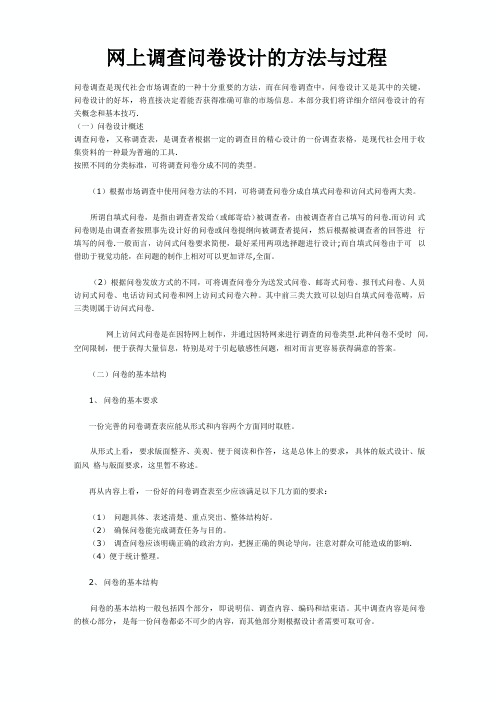
网上调查问卷设计的方法与过程问卷调查是现代社会市场调查的一种十分重要的方法,而在问卷调查中,问卷设计又是其中的关键,问卷设计的好坏,将直接决定着能否获得准确可靠的市场信息。
本部分我们将详细介绍问卷设计的有关概念和基本技巧.(一)问卷设计概述调查问卷,又称调查表,是调查者根据一定的调查目的精心设计的一份调查表格,是现代社会用于收集资料的一种最为普遍的工具.按照不同的分类标准,可将调查问卷分成不同的类型。
(1)根据市场调查中使用问卷方法的不同,可将调查问卷分成自填式问卷和访问式问卷两大类。
所谓自填式问卷,是指由调查者发给(或邮寄给)被调查者,由被调查者自己填写的问卷.而访问式问卷则是由调查者按照事先设计好的问卷或问卷提纲向被调查者提问,然后根据被调查者的回答进行填写的问卷.一般而言,访问式问卷要求简便,最好采用两项选择题进行设计;而自填式问卷由于可以借助于视觉功能,在问题的制作上相对可以更加详尽,全面。
(2)根据问卷发放方式的不同,可将调查问卷分为送发式问卷、邮寄式问卷、报刊式问卷、人员访问式问卷、电话访问式问卷和网上访问式问卷六种。
其中前三类大致可以划归自填式问卷范畴,后三类则属于访问式问卷.网上访问式问卷是在因特网上制作,并通过因特网来进行调查的问卷类型.此种问卷不受时间,空间限制,便于获得大量信息,特别是对于引起敏感性问题,相对而言更容易获得满意的答案。
(二)问卷的基本结构1、问卷的基本要求一份完善的问卷调查表应能从形式和内容两个方面同时取胜。
从形式上看,要求版面整齐、美观、便于阅读和作答,这是总体上的要求,具体的版式设计、版面风格与版面要求,这里暂不称述。
再从内容上看,一份好的问卷调查表至少应该满足以下几方面的要求:(1)问题具体、表述清楚、重点突出、整体结构好。
(2)确保问卷能完成调查任务与目的。
(3)调查问卷应该明确正确的政治方向,把握正确的舆论导向,注意对群众可能造成的影响.(4)便于统计整理。
如何进行有效的问卷设计和调查分析
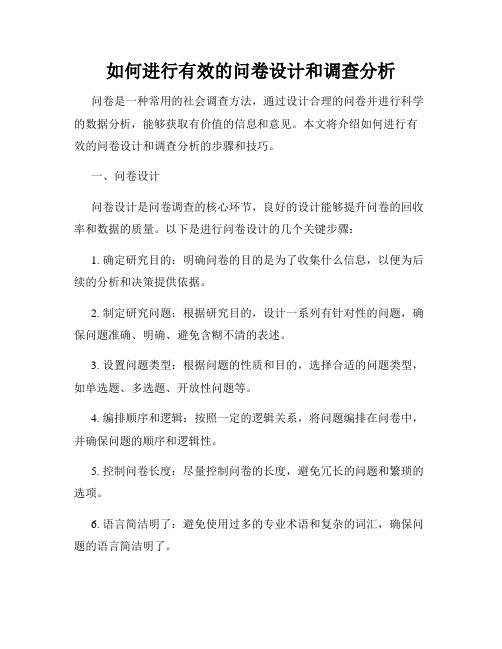
如何进行有效的问卷设计和调查分析问卷是一种常用的社会调查方法,通过设计合理的问卷并进行科学的数据分析,能够获取有价值的信息和意见。
本文将介绍如何进行有效的问卷设计和调查分析的步骤和技巧。
一、问卷设计问卷设计是问卷调查的核心环节,良好的设计能够提升问卷的回收率和数据的质量。
以下是进行问卷设计的几个关键步骤:1. 确定研究目的:明确问卷的目的是为了收集什么信息,以便为后续的分析和决策提供依据。
2. 制定研究问题:根据研究目的,设计一系列有针对性的问题,确保问题准确、明确、避免含糊不清的表述。
3. 设置问题类型:根据问题的性质和目的,选择合适的问题类型,如单选题、多选题、开放性问题等。
4. 编排顺序和逻辑:按照一定的逻辑关系,将问题编排在问卷中,并确保问题的顺序和逻辑性。
5. 控制问卷长度:尽量控制问卷的长度,避免冗长的问题和繁琐的选项。
6. 语言简洁明了:避免使用过多的专业术语和复杂的词汇,确保问题的语言简洁明了。
7. 使用可选项限制回答范围:对于一些需要限制回答范围的问题,可以使用可选项或排他选项进行设计,以提高数据的准确性。
二、问卷调查问卷调查是将设计好的问卷发放给被调查者并收集数据的过程。
以下是一些进行问卷调查的技巧和方法:1. 定位受众:确定被调查者的身份和特征,选择合适的调查方式,如面对面访谈、电话访问、网络调查等。
2. 确保样本的代表性:样本的代表性对于问卷调查的结果至关重要,要确保样本具有一定的普适性和代表性。
3. 提高回收率:采用适当的方式和方法提高问卷的回收率,如提供奖励、追踪回收进度、提前预约等。
4. 保护被调查者的隐私:对于一些敏感问题,要保证被调查者的隐私,确保数据的真实性和可信度。
5. 数据录入和清理:将纸质问卷的数据录入电脑或使用在线调查工具进行数据收集,并进行数据清理和筛选,确保数据的质量和准确性。
三、问卷分析问卷分析是对收集到的数据进行整理、计算和解读的过程。
以下是一些进行问卷分析的方法和技巧:1. 数据整理:对收集到的数据进行整理和分类,并进行初步的清洗和筛选。
hinkin问卷开发步骤

hinkin问卷开发步骤-概述说明以及解释1.引言1.1 概述概述部分的内容:在现代社会中,问卷调查已经成为了一种常见且有效的研究方法和工具。
问卷调查可以用于收集各种不同的数据,包括观点、态度、行为和需求等,广泛应用于社会科学研究、市场调研、企业管理等领域。
然而,在进行一项有效的问卷调查之前,我们需要经历一系列的步骤来确保问卷的科学性和适用性。
本文将介绍一套完整的问卷开发步骤,帮助读者了解如何有效地设计和开发一个问题清晰、结构合理的问卷调查。
主要包括四个主要步骤:问题确定、问题编写、问卷设计和数据分析。
每个步骤都有具体的子步骤和要点,以确保问卷的质量和有效性。
在第一步骤中,我们将详细描述如何确定研究问题和目标受众,以及如何测量所需的研究目标。
并且,我们将介绍如何选择问题形式,包括开放式问题和封闭式问题。
在第二步骤中,我们将详细介绍如何编写问题,并且探讨如何确定问题的顺序和格式。
此外,我们还将强调问题测试的重要性,并介绍一些常用的测试方法。
在第三步骤中,我们将介绍如何设计问卷的整体布局和风格。
我们将讨论问卷设计的一些基本原则和技巧,并提供一些实用的建议。
同时,我们还将强调进行问卷测试的重要性,以确保问卷的有效性和可靠性。
在第四步骤中,我们将介绍如何进行数据收集和分析。
我们将讨论一些常用的数据收集方法,并介绍一些数据分析的基本原则和技巧。
此外,我们还将探讨如何解释和报告研究结果,以帮助读者更好地理解和利用研究成果。
总之,本文将帮助读者全面了解整个问卷开发的过程和各个步骤的要点和技巧。
通过掌握这些知识和方法,读者将能够设计和开发出高质量和有效的问卷调查,并从中获得准确、可靠的研究结果。
文章结构部分的内容可以如下编写:1.2 文章结构为了清晰、有条理地呈现问卷开发的步骤和过程,本文将分为以下几个部分来进行阐述和讨论。
首先,在引言部分,我们会对本文的主题进行概述,简要介绍问卷开发的目的和意义。
接下来,我们会对整篇文章的结构进行说明,给读者提供一个整体的导向,方便他们对文章内容的理解和阅读。
市场调查问卷设计的程序与技巧

市场调查问卷设计的程序与技巧市场调查问卷设计是市场研究的关键步骤之一,它可以帮助研究人员收集客户需求、评估产品市场潜力、了解竞争对手以及调查市场趋势等信息。
本文将介绍市场调查问卷设计的程序和技巧。
市场调查问卷设计的程序如下:1. 确定调查目的:在设计问卷之前,首先要明确调查的目的。
例如,想要了解目标市场对某种产品的需求、评估产品的市场潜力、了解竞争对手的表现等。
2. 确定调查内容:根据调查目的,确定问卷中需要包含的问题和内容。
问题可以包括开放性问题和封闭性问题。
开放性问题可以让受访者自由回答,封闭性问题可以提供选项供受访者选择。
3. 制定调查方法:根据目标受众和可行性,制定调查方法。
常见的调查方法包括在线调查、电话调查、面对面访谈等。
确定合适的调查方法有助于提高问卷的回收率和有效性。
4. 设计问卷结构:将确定的问题有机地组合起来,构成一个有逻辑、清晰的问卷结构。
问卷的开头可以包括一些简短的说明和提问者的自我介绍,以提高受访者的参与度和信任感。
5. 制定问卷题目和选项:对于每个问题,需要制定清晰、简洁的题目,以便受访者能够理解并回答。
选项也需要具有充分的代表性和多样性,以覆盖各种可能的答案。
6. 设计问卷布局:问卷的布局应该简洁明了,避免过多的文字和信息,以免让受访者感到繁琐和厌烦。
合理利用空白和分段,使问卷的内容整齐有序。
7. 评估问卷的有效性:在正式发出问卷之前,可以找一些人进行试用,并收集他们的反馈意见,以评估问卷的有效性和可行性。
根据反馈意见,对问卷进行必要的调整和修改。
8. 发放和收集问卷:根据确定的调查方法发放问卷,可以通过邮件、电子邮件、社交媒体等方式将问卷发送给目标受众。
同时,设定截止日期和提醒受访者及时回答。
9. 数据分析:在问卷收集完毕后,对收集到的数据进行整理和分析。
可以使用统计软件或数据分析工具对数据进行处理和解读,提取有价值的信息和结论。
市场调查问卷设计的技巧如下:1. 简洁明了:问卷的题目和问题应该简洁明了,语言通俗易懂,避免使用过于专业和复杂的术语。
论文写作中的调查问卷设计与分析
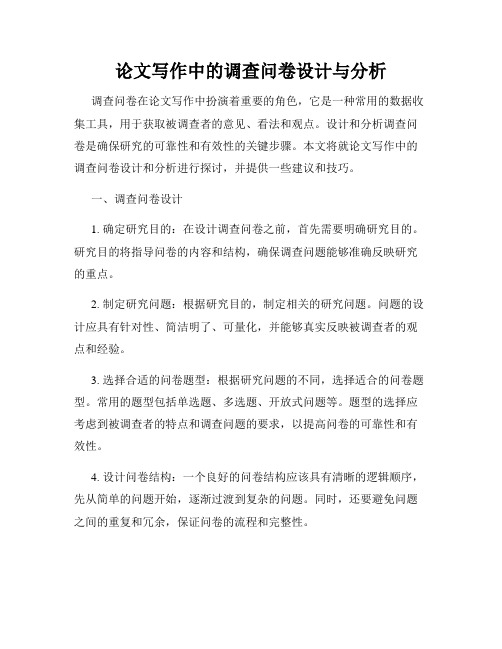
论文写作中的调查问卷设计与分析调查问卷在论文写作中扮演着重要的角色,它是一种常用的数据收集工具,用于获取被调查者的意见、看法和观点。
设计和分析调查问卷是确保研究的可靠性和有效性的关键步骤。
本文将就论文写作中的调查问卷设计和分析进行探讨,并提供一些建议和技巧。
一、调查问卷设计1. 确定研究目的:在设计调查问卷之前,首先需要明确研究目的。
研究目的将指导问卷的内容和结构,确保调查问题能够准确反映研究的重点。
2. 制定研究问题:根据研究目的,制定相关的研究问题。
问题的设计应具有针对性、简洁明了、可量化,并能够真实反映被调查者的观点和经验。
3. 选择合适的问卷题型:根据研究问题的不同,选择适合的问卷题型。
常用的题型包括单选题、多选题、开放式问题等。
题型的选择应考虑到被调查者的特点和调查问题的要求,以提高问卷的可靠性和有效性。
4. 设计问卷结构:一个良好的问卷结构应该具有清晰的逻辑顺序,先从简单的问题开始,逐渐过渡到复杂的问题。
同时,还要避免问题之间的重复和冗余,保证问卷的流程和完整性。
5. 注意语言表达:在设计调查问题时,要注意使用简单明了的语言,避免使用太专业或难以理解的术语。
问题的表述应具有客观性和中立性,不要引导被调查者的回答。
6. 进行预测试:在正式使用调查问卷之前,进行预测试是必要的。
通过预测试,可以发现和解决潜在问题和疑惑,确保问卷的准确性和可行性。
二、调查问卷分析1. 数据收集与整理:在收集调查问卷数据之前,要确保问卷的分发和回收工作顺利进行。
收集到的数据应当进行整理,确保数据的准确性和完整性。
2. 数据编码与录入:对于开放式问题,需要进行数据编码以便于统一管理和分析。
同时,将纸质问卷数据进行电子化录入,以减少误差和提高效率。
3. 数据清洗与处理:在进行数据分析之前,需要进行数据清洗和处理。
数据清洗的目的是排除异常值和不符合研究要求的数据,确保数据的质量和可靠性。
4. 统计分析与结果呈现:根据研究问题和数据的性质,选择合适的统计方法进行数据分析。
基于Web的问卷调查系统的设计与实现
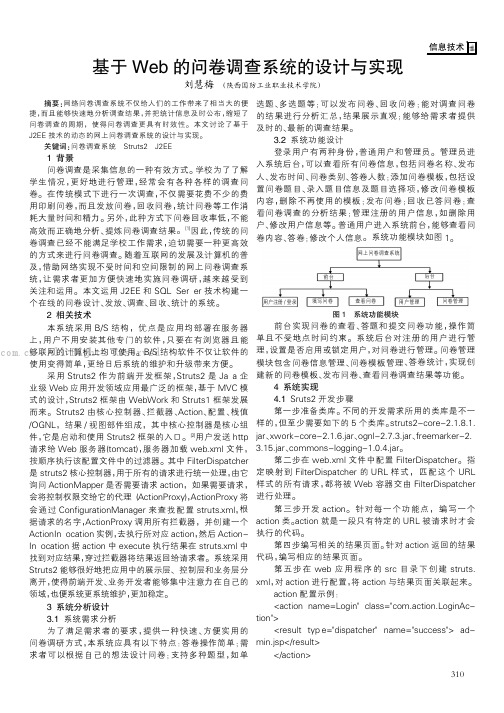
摘要:网络问卷调查系统不仅给人们的工作带来了相当大的便捷,而且能够快速地分析调查结果,并把统计信息及时公布,缩短了问卷调查的周期,使得问卷调查更具有时效性。
本文讨论了基于J2EE技术的动态的网上问卷调查系统的设计与实现。
关键词:问卷调查系统Struts2J2EE1背景问卷调查是采集信息的一种有效方式。
学校为了了解学生情况,更好地进行管理,经常会有各种各样的调查问卷。
在传统模式下进行一次调查,不仅需要花费不少的费用印刷问卷,而且发放问卷,回收问卷,统计问卷等工作消耗大量时间和精力。
另外,此种方式下问卷回收率低,不能高效而正确地分析、提炼问卷调查结果。
[1]因此,传统的问卷调查已经不能满足学校工作需求,迫切需要一种更高效的方式来进行问卷调查。
随着互联网的发展及计算机的普及,借助网络实现不受时间和空间限制的网上问卷调查系统,让需求者更加方便快速地实施问卷调研,越来越受到关注和运用。
本文运用J2EE和SQL Server技术构建一个在线的问卷设计、发放、调查、回收、统计的系统。
2相关技术本系统采用B/S结构,优点是应用均部署在服务器上,用户不用安装其他专门的软件,只要在有浏览器且能够联网的计算机上均可使用。
B/S结构软件不仅让软件的使用变得简单,更给日后系统的维护和升级带来方便。
采用Struts2作为前端开发框架,Struts2是Java企业级Web应用开发领域应用最广泛的框架,基于MVC模式的设计,Struts2框架由WebWork和Struts1框架发展而来。
Struts2由核心控制器、拦截器、Action、配置、栈值/OGNL,结果/视图部件组成,其中核心控制器是核心组件,它是启动和使用Struts2框架的入口。
[2]用户发送http 请求给Web服务器(tomcat),服务器加载web.xml文件,按顺序执行该配置文件中的过滤器。
其中FilterDispatcher 是struts2核心控制器,用于所有的请求进行统一处理,由它询问ActionMapper是否需要请求action,如果需要请求,会将控制权限交给它的代理(ActionProxy),ActionProxy将会通过ConfigurationManager来查找配置struts.xml,根据请求的名字,ActionProxy调用所有拦截器,并创建一个ActionInvocation实例,去执行所对应action,然后Action-Invocation据action中execute执行结果在struts.xml中找到对应结果,穿过拦截器将结果返回给请求者。
android studio调查问卷开发案例

android studio调查问卷开发案例开发一个Android Studio调查问卷应用需要经过几个关键步骤。
以下是一个简单的开发案例,包括需求分析、设计、编码和测试。
需求分析首先,明确应用的需求。
一个调查问卷应用通常需要以下功能:显示问卷问题收集用户回答提交调查结果统计分析数据设计在设计阶段,你需要确定应用的界面和交互方式。
以下是一些关键设计考虑:用户界面:简洁、直观的界面,易于导航。
数据存储:使用SQLite数据库存储用户数据。
网络连接:如果需要实时提交或同步数据,考虑使用网络API。
编码在编码阶段,你需要实现应用的功能。
以下是关键步骤:1. 创建新项目:在Android Studio中创建一个新的Android项目。
2. 设计数据库模型:定义一个或多个表格来存储问卷数据。
3. 创建用户界面:使用XML布局文件创建问卷的界面。
4. 编写逻辑代码:在Java或Kotlin文件中实现问卷逻辑,如获取答案、提交结果等。
5. 集成网络API(可选):如果需要实时提交或同步数据,调用第三方API 或自己开发API。
6. 测试:在模拟器或真实设备上测试应用的功能。
测试完成编码后,进行详尽的测试以确保应用的稳定性和性能。
测试应包括:功能测试:确保所有功能按预期工作。
性能测试:检查应用的响应时间和资源使用情况。
兼容性测试:在不同的设备和Android版本上测试应用。
安全测试:检查应用是否存在安全漏洞,如SQL注入等。
部署和发布完成测试后,你可以部署应用。
这通常涉及打包应用(APK文件),然后将其发布到Google Play商店或其他平台。
确保你遵循了所有发布指南和合规要求。
- 1、下载文档前请自行甄别文档内容的完整性,平台不提供额外的编辑、内容补充、找答案等附加服务。
- 2、"仅部分预览"的文档,不可在线预览部分如存在完整性等问题,可反馈申请退款(可完整预览的文档不适用该条件!)。
- 3、如文档侵犯您的权益,请联系客服反馈,我们会尽快为您处理(人工客服工作时间:9:00-18:30)。
works to be able to control it
量表修订与编制:以中文儿童版NEP量表的修订为例
量表核心要素
• NEP6:The earth has plenty of natural resources if we just learn how to develop them (r)
• NEP11:The earth is like a spaceship with very limited room and resources
• NEP2:Humans have the right to modify the natural environmental to suit their needs (r)
• NEP7:Plants and animals have as much right as humans to exist • NEP12:Humans were meant to rule over the rest of nature (r)
调查问卷的设计
为何要关注成效评价呢?
• 问题:我们的环境教育小学绿色教 育行动(EEI); 中小学环境教育社会实 践基地项目; ……
教育活动
绿色学校
教育产出
? 成果
“学会了什么/达 到了什么水平”
环境教育成效评价的思维
以自然之友《废弃物与生命》课程为例:
资料来源:2016年10月南京培训内部交流资料
高信度;高效度 低信度;低效度 高信度;低效度 低信度;有效度
1 借用已发表的量表 (推荐)
量表修订与编制:以中文儿童版NEP量表的修订为例
• NEP量表
– New Environmental/Ecological Paradigm(新环境/生态范式) – 由美国环境社会学家邓拉普(Dunlap & Van Liere,1978;Dunlap
增长的极限
Antianthropocentrism
反人类中心主义
Balance of nature
自然的平衡
Antiexceptionalism
反人类排外主义
Eco-crisis
生态危机
指标(项目)
• NEP1:We are approaching the limit of the number of people the earth can support
• 操作化定义(目的
是使目标得以测量)
•
– 信度:可靠度
正式问卷(结果测量)
•
• 修订/构建量表
界定目标
• 确定目标 • 定义目标中的概念
结果评价(后测) 项目成效评价(后
测+对照;前测-后 测)
其他延伸(影响因
素;态度或行为发展 机制)
过程性(如参与互动情况) 结果性(如获得知识、提升
态度、培养责任感以及行为 意愿)
环境教育成效评价的思维
以自然之友《废弃物与生命》课程为例:
(理解:知识目标) (重要性:价值观|态度目标)
(践行:行为目标)
(能力:技能目标) 资料来源:2016年10月南京培训内部交流资料
环境教育成效评价的方法与技巧
• 成效评价基本流程
成效评价
收集数据
•
• 预调研(量表适用性) •
构建指标
– 效度:准确度
• NEP3:When humans interfere with nature it often produces disastrous consequences
• NEP8:The balance of nature is strong enough to cope with the impacts of modern industrial nations (r)
✓ 对科学教学与评价的启示5: 多阅读,尝试用多方法评估
概念图: 什么是热带雨林
前测
后测: 新增的知识主要源于小 组课题探究
Y = b0 + b1M1 + b2M2 + c'X
X c'
M1
b1
Y
b2
M2
效度:测量所得准确反映所要研究的概念的程度; 信度:重复测量得到相同结果的可能性
效度:测量所得准确反映所要研究的概念的程度; 信度:重复测量得到相同结果的可能性
• 内N容E维P度量表的结构
指标(项目)
Limits to growth 增长的极限
• NEP1:We are approaching the limit of the number of people the earth can support • NEP6:The earth has plenty of natural resources if we just learn how to develop them (r) • NEP11:The earth is like a spaceship with very limited room and resources
et al., 2000)提出 – 理论内涵:人们对自然环境以及人与自然环境之间关系的一般看法(
生态世界观、环境信念、环境关心) – 是目前国际环境社会学界使用最广泛的环境态度量表
JEE, 2008, 40(1)
量表修订与编制:以中文儿童版NEP量表的修订为例
• NEP量表的结构
内容维度
Limits to growth
• NEP14:The balance of nature is very delicate and easily upset (r)
• NEP5:Humans are severely abusing the environment • NEP10:The so-called “ecological crisis” facing humankind has
• NEP13:Humans were meant to rule over the rest of nature
• NEP4:Human ingenuity will insure that we do NOT make the earth unlivable (r)
• NEP9:Despite our special abilities, humans are still subject to the laws of nature
